The golf course maintenance robot market is expected to grow steadily over the next decade, with a compound annual growth rate of approximately 7.8%. In 2025, the market is valued at USD 286.4 million, and it is projected to reach USD 607 million by 2035, reflecting an absolute growth of USD 320.6 million. This growth is driven by rising labor costs in golf course management, demand for consistent turf quality, and the adoption of advanced technologies such as artificial intelligence and sensor-based systems. Golf course operators are increasingly replacing manual maintenance with autonomous mowing, irrigation, and turf management solutions, enabling precise, efficient, and resource-optimized operations.
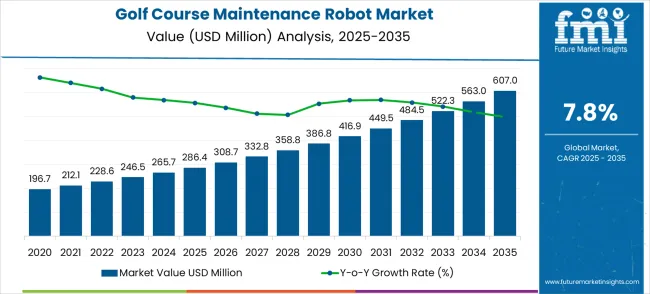
The market’s growth trajectory highlights the gradual but steady acceptance of robotic solutions, particularly in regions with extensive facilities and a focus on operational efficiency. Technological advancements, energy-efficient designs, and awareness of cost benefits are expected to encourage further adoption. This trend marks a shift from traditional labor-intensive practices toward automation-driven maintenance, ensuring better turf management and improved course aesthetics. The golf course maintenance robot market demonstrates a clear pattern of continuous expansion, offering opportunities for manufacturers and service providers to capitalize on growing demand, with absolute growth signaling long-term market potential and a steady increase in adoption across the industry.
The golf course maintenance robot market is influenced by several parent markets, each contributing differently to its development. The robotics and automation market holds the largest influence at around 40%, supplying advanced navigation, sensors, and AI technologies. The sports and recreation equipment market contributes approximately 25%, providing demand and standards for golf course machinery. Lawn and turf management equipment accounts for 20%, driving adoption through equipment familiarity and maintenance integration. The agricultural robotics market adds 10%, offering crossover technologies in autonomous navigation and efficiency. Finally, facility management and maintenance contributes 5%, supporting operational practices. Together, these markets shape innovation, adoption, and growth strategies in golf course maintenance robotics.
The golf course maintenance robot market is experiencing transformative trends. Integration of AI and machine learning enables robots to navigate complex terrains and optimize mowing paths. Real-time kinematic GPS systems allow precise operations without boundary wires. Electrification and battery-powered models are gaining traction for eco-friendly, quiet performance. Manufacturers like Toro and Belrobotics focus on autonomous, high-efficiency models, and labor savings. There is increasing adoption in high-density courses and training facilities where operational efficiency is critical. Innovations in modular design, multi-task functionality, and remote monitoring are shaping the future of robotic maintenance, improving precision, cost efficiency, and environmental compliance.
How Golf Industry Associations Could Advance Technology Standards and Best Practices?
How Golf Course Operators Could Optimize Facility Management and Operational Efficiency?
How Technology Manufacturers Could Drive Innovation and Market Expansion?
How Equipment Distributors and Service Providers Could Enhance Market Access?
How Recreational Facility Developers Could Integrate Advanced Maintenance Solutions?
How Investors and Financial Enablers Could Support Market Development and Innovation?
| Metric | Value |
|---|---|
| Estimated Value in (2025E) | USD 286.4 million |
| Forecast Value in (2035F) | USD 607.0 million |
| Forecast CAGR (2025 to 2035) | 7.8% |
From 2030 to 2035, the market is forecast to grow from USD 416.9 million to USD 607.0 million, adding another USD 190.1 million, which constitutes 59.3% of the ten-year expansion. This period is expected to be characterized by the expansion of artificial intelligence and machine learning technologies, the integration of advanced sensors and GPS navigation systems, and the development of specialized robotic solutions for complex course maintenance tasks.
Between 2020 and 2025, the golf course maintenance robot market experienced robust growth, driven by increasing labor shortages in groundskeeping and growing recognition of robotic systems as essential tools for maintaining consistent turf quality with reduced operational costs. The market developed as golf course operators recognized the potential for maintenance robots to enhance operational efficiency while providing precise and reliable groundskeeping performance. Technological advancement in autonomous navigation and battery technology began emphasizing the critical importance of maintaining turf quality and operational reliability in automated course maintenance applications.
Market expansion is being supported by the increasing global demand for efficient turf maintenance solutions and the corresponding need for autonomous groundskeeping systems that can provide consistent maintenance quality while reducing labor dependency across various golf course operations. Modern golf course operators are increasingly focused on implementing maintenance solutions that can reduce operational costs, minimize manual labor requirements, and provide consistent turf quality across different course areas and seasonal conditions. Golf course maintenance robots' proven ability to deliver automated maintenance capabilities, enhanced precision, and operational reliability makes them essential equipment for contemporary golf course management and recreational facility maintenance.
Golf facility operators' preference for equipment that combines maintenance precision with operational cost-effectiveness and labor efficiency is creating opportunities for innovative robotic implementations. The rising influence of premium recreational experiences and course quality expectations is also contributing to increased adoption of golf course maintenance robots that can provide consistent maintenance performance without disrupting course operations or player experiences.
The golf course maintenance robot market is growing steadily, driven by increasing automation in course upkeep and operational efficiency. Lawn maintenance robots dominate the function segment with a 70% share, while ball picking robots account for 25% and other functions make up 5%. Among applications, golf clubs lead with a 77.5% share, followed by third-party golf operation companies at 22.4%. These segments offer the most attractive investment opportunities, reflecting high adoption rates in golf clubs and a growing preference for automated solutions to reduce labor costs and maintain consistent turf quality.

Lawn maintenance robots, holding a 70% share of the function segment, are the most widely deployed due to their efficiency, precision, and ability to maintain consistent turf quality. These robots handle mowing, trimming, and edging tasks, reducing labor requirements and improving course aesthetics. Leading manufacturers include Husqvarna, Robomow, Friendly Robotics, and Ambrogio. Lawn maintenance robots offer programmable operation, battery efficiency, and integration with GPS-based navigation systems, supporting large-scale golf course upkeep while minimizing human intervention. Their ability to maintain uniform grass height and appearance reinforces their dominance in the market.
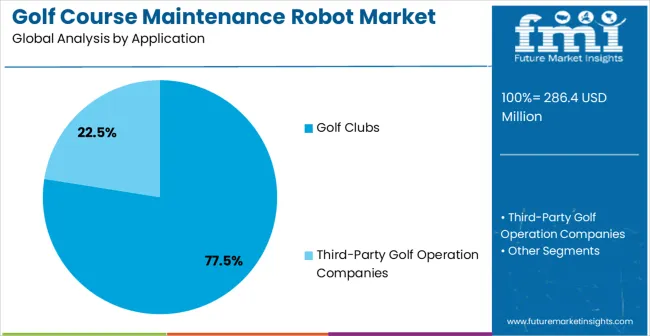
Golf clubs, representing 77.5% of the market, remain the largest application segment for maintenance robots. These robots are extensively used for lawn upkeep, ball collection, and course management to ensure optimal playing conditions. Manufacturers such as Husqvarna, Robomow, Friendly Robotics, and Ambrogio provide solutions designed for reliability, efficiency, and ease of integration into daily operations. Growth is fueled by increasing adoption of automated solutions to reduce labor costs and maintain high-quality course standards, making golf clubs the primary focus for investment in this market.
The golf course maintenance robot market is expanding as courses adopt equipment that automates key tasks. Robots handle mowing, turf management, irrigation monitoring, and ball collection, reducing labor requirements while maintaining consistent quality. Increased global interest in golf and growth of new courses are driving demand for robotic solutions. Advanced navigation systems, including GPS and sensors, allow precise operation on varying terrain without damaging grass or greens. Energy-efficient electric designs reduce operating costs and environmental impact. Integration of multiple functions in a single robot enhances operational efficiency and flexibility. By offering reliable, time-saving solutions, these robots are becoming a core part of modern golf course operations, helping facilities maintain high standards while reducing manual labor and operational complexity.
Despite strong growth, adoption of golf course maintenance robots faces several challenges. High initial investment costs may deter smaller or budget-constrained facilities from purchasing advanced systems. Operating these robots often requires trained personnel to manage route programming, schedules, and routine checks. Maintenance costs, including battery replacement and occasional component servicing, add to long-term expenses. Terrain variations, steep slopes, or uneven surfaces can impact performance, sometimes requiring specialized models or adaptations. Limited awareness of the advantages of robotic systems in certain regions can further slow adoption. Space constraints in smaller courses may also restrict deployment efficiency. These factors collectively restrict widespread uptake, particularly in facilities with limited financial or technical resources.\
Market trends indicate a shift toward intelligent and green maintenance solutions. Golf course robots increasingly feature GPS navigation, sensors, and adaptive algorithms to optimize mowing patterns, irrigation schedules, and ball collection. Energy-efficient, electric-powered systems reduce operating costs and environmental impact. Remote monitoring platforms allow operators to oversee multiple robots, track performance, and receive maintenance alerts. Multi-functional, modular designs are gaining popularity, enabling a single device to handle mowing, trimming, or collection tasks. Lightweight and terrain-adaptive models minimize grass damage while improving efficiency. These innovations reflect a move toward highly flexible, environmentally conscious, and technologically advanced robotic solutions that streamline golf course management while maintaining consistent quality and operational standards.
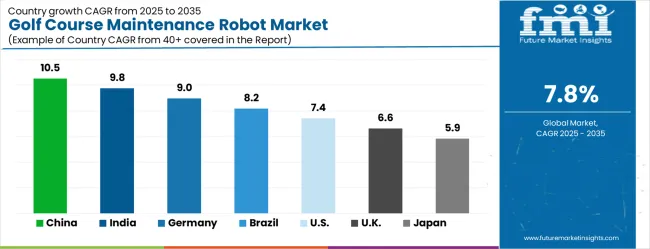
| Country | CAGR (2025-2035) |
|---|---|
| China | 10.5% |
| India | 9.8% |
| Germany | 9.0% |
| Brazil | 8.2% |
| USA | 7.4% |
| UK | 6.6% |
| Japan | 5.9% |
In 2025, the global golf course maintenance robots market is projected to grow at a CAGR of 7.8%, corresponding to a multiplication factor of 2.12 over the 2025–2035 period. China leads at 10.5% (2.04x), 4.1 points above the global average, driven by rising golf course development and increasing adoption of automation in sports facilities. India follows at 9.8% (1.98x), 2.9 points higher than global growth, supported by expanding sports infrastructure, both part of BRICS along with Brazil, which records 8.2% (1.81x), slightly above the global CAGR due to growth in recreational and professional golf activities. Germany grows at 9.0% (1.95x), 1.7 points above the global rate, reflecting automation in European sports facilities. The USA shows 7.4% (1.77x), while the UK at 6.6% (1.72x) and Japan at 5.9% (1.68x) lag behind. ASEAN and Oceania are adopting these robots at 10–13% (1.72–1.95x), driven by modernization of golf courses and labor efficiency initiatives.
The report covers an in-depth analysis of 40+ countries; seven top-performing countries are highlighted below.
The golf course maintenance robots market in China is projected to exhibit exceptional growth with a CAGR of 10.5% through 2035, driven by expanding recreational infrastructure and rapidly growing golf facility development supported by government tourism and leisure industry initiatives. The country's increasing investment in premium recreational facilities and growing emphasis on automation technology are creating substantial demand for advanced maintenance robotics solutions. Major golf facility operators and recreational infrastructure developers are establishing comprehensive robotic maintenance capabilities to serve both domestic and international tourism markets.
The demand for golf course maintenance robots in India is expanding at a CAGR of 9.8%, supported by the country's rapid expansion of recreational infrastructure, growing golf facility development, and increasing emphasis on operational efficiency and modern facility management practices. The country's expanding tourism sector and growing premium recreational facilities are driving demand for reliable automated maintenance capabilities. International robotics manufacturers and domestic distributors are establishing extensive distribution networks to address the growing demand for golf course automation equipment.
The golf course maintenance robots in market in Germany is expanding at a CAGR of 9.0%, supported by the country's advanced manufacturing capabilities, strong emphasis on technological innovation, and robust demand for high-precision automated systems among premium recreational facilities. The nation's established recreational facility sector and focus on operational excellence are driving sophisticated robotic maintenance capabilities throughout the golf and leisure industry. Leading manufacturers are investing extensively in advanced robotic development and precision automation methods to serve both domestic and export markets.
The demand for golf course maintenance robots in Brazil is growing at a CAGR of 8.2%, driven by expanding recreational facility development, increasing tourism infrastructure investment, and growing emphasis on premium facility operations and maintenance standards. The country's growing tourism sector and modernization of recreational facilities are supporting demand for advanced automated maintenance solutions across major resort and facility regions. Recreational facility operators and resort developers are establishing comprehensive robotic maintenance capabilities to serve both domestic and international tourism requirements.
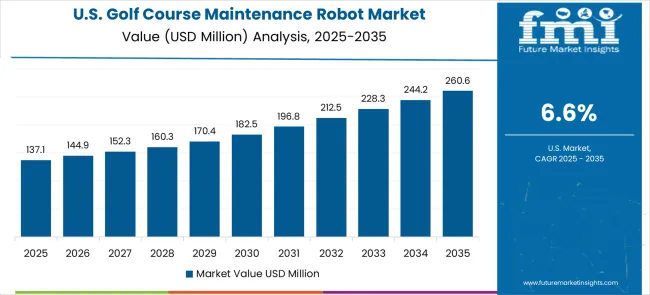
The demand for golf course maintenance robots in the USA is expanding at a CAGR of 7.4%, supported by the country's established golf industry infrastructure, emphasis on operational cost optimization, and the mature recreational facility sector demanding efficient maintenance solutions. The nation's extensive golf facility network and focus on operational efficiency are driving demand for advanced robotic maintenance technologies, emphasizing reliability and cost-effectiveness. Manufacturers are investing in comprehensive product portfolios to serve both premium and public golf facilities with proven automated maintenance solutions.
The golf course maintenance robots market in the UK is growing at a CAGR of 6.6%, driven by the country's premium golf facility upgrade programs, established recreational sector, and emphasis on maintenance automation and operational efficiency improvement. The UK's mature golf industry and focus on facility excellence are supporting investment in advanced robotic maintenance technologies throughout established golf clubs and premium facilities. Leading facility operators are establishing comprehensive automated maintenance capabilities to serve both member and visitor experiences with reliable maintenance performance.
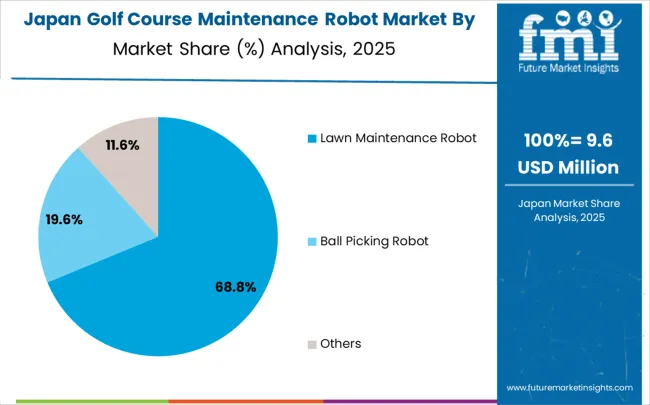
The golf course maintenance robots in Japan is expanding at a CAGR of 5.9%, supported by the country's focus on precision robotics, emphasis on advanced automation technologies, and strong preference for high-quality maintenance equipment. Japan's sophisticated manufacturing industry and focus on technological precision are driving demand for advanced maintenance robotics, including autonomous navigation systems and precision cutting technologies. Leading facility operators are investing in specialized capabilities to serve premium golf facilities and recreational venues with advanced automated maintenance solutions.
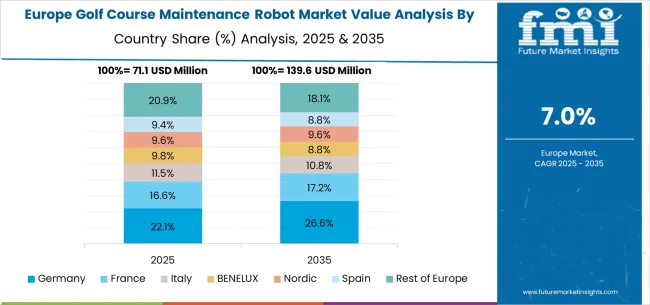
The golf course maintenance robot market in Europe is projected to grow from USD 66.5 million in 2025 to USD 141.1 million by 2035, registering a CAGR of 7.8% over the forecast period. Germany is expected to maintain its leadership position with a 31.8% market share in 2025, moderating slightly to 31.5% by 2035, supported by its strong manufacturing base, advanced robotics technology capabilities, and comprehensive recreational facility networks serving major European markets.
The United Kingdom follows with a 26.3% share in 2025, projected to reach 26.5% by 2035, driven by robust premium golf facility infrastructure, an established recreational sector, and strong demand for maintenance automation solutions across golf clubs and leisure facilities. France holds an 18.9% share in 2025, rising to 19.1% by 2035, supported by recreational facility development and increasing adoption of automated maintenance technologies in premium venue operations. Italy records 10.7% in 2025, inching to 10.8% by 2035, with growth underpinned by tourism facility modernization and increasing emphasis on operational efficiency in recreational venues. Spain contributes 7.2% in 2025, moving to 7.3% by 2035, supported by expanding tourism infrastructure and recreational facility development programs. The Netherlands maintains a 2.8% share in 2025, growing to 2.9% by 2035. The Rest of Europe region, including Nordic countries, Eastern Europe, Belgium, Switzerland, and Austria, is anticipated to lose its momentum during the forecast period, expanding its collective share from 2.3% to 1.9% by 2035, attributed to increasing adoption of advanced maintenance automation in Nordic countries and growing recreational activities across Eastern European markets implementing facility modernization programs.
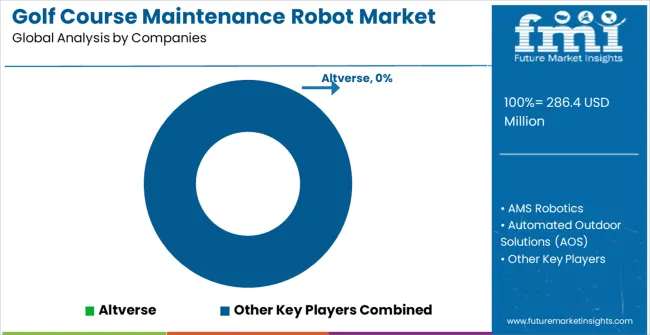
The golf course maintenance robot market is characterized by competition among established robotics manufacturers, specialized turf maintenance equipment providers, and integrated facility automation companies. Companies are investing in advanced robotics technology research, autonomous navigation development, precision maintenance capabilities, and comprehensive service portfolios to deliver consistent, high-performance, and reliable automated maintenance solutions. Innovation in artificial intelligence systems, sensor technologies, and battery management is central to strengthening market position and competitive advantage.
Altverse leads the market with a strong market share, offering comprehensive automated maintenance solutions with a focus on precision turf care and advanced navigation capabilities. AMS Robotics provides specialized golf course robotics with an emphasis on autonomous operation and facility integration. Automated Outdoor Solutions delivers innovative maintenance automation with a focus on comprehensive facility solutions and operational efficiency. Cranham Golf Robotics focuses on golf-specific maintenance automation and specialized course care applications. Wayrobo offers advanced robotic solutions with a focus on precision navigation and adaptive maintenance programming.
| Items | Values |
|---|---|
| Quantitative Units (2025) | USD million |
| Function | Lawn Maintenance Robot, Ball Picking Robot, Others |
| Application | Golf Clubs, Third-Party Golf Operation Companies |
| Regions Covered | North America, Europe, East Asia, South Asia & Pacific, Latin America, Middle East & Africa |
| Countries Covered | United States, Canada, United Kingdom, Germany, France, China, Japan, South Korea, India, Brazil, Australia and 40+ countries |
| Key Companies Profiled | Altverse, AMS Robotics, Automated Outdoor Solutions, Cranham Golf Robotics, and Wayrobo |
| Additional Attributes | Dollar sales by function and application category, regional demand trends, competitive landscape, technological advancements in robotics systems, automation innovation, AI integration development, and operational optimization |
North America
Europe
East Asia
South Asia & Pacific
Latin America
Middle East & Africa
The global golf course maintenance robot market is estimated to be valued at USD 286.4 million in 2025.
The market size for the golf course maintenance robot market is projected to reach USD 607.0 million by 2035.
The golf course maintenance robot market is expected to grow at a 7.8% CAGR between 2025 and 2035.
The key product types in golf course maintenance robot market are lawn maintenance robot, ball picking robot and others.
In terms of application, golf clubs segment to command 77.5% share in the golf course maintenance robot market in 2025.






Full Research Suite comprises of:
Market outlook & trends analysis
Interviews & case studies
Strategic recommendations
Vendor profiles & capabilities analysis
5-year forecasts
8 regions and 60+ country-level data splits
Market segment data splits
12 months of continuous data updates
DELIVERED AS:
PDF EXCEL ONLINE
Golf Shoes Market Size and Share Forecast Outlook 2025 to 2035
Golf Cart Batteries Market Size and Share Forecast Outlook 2025 to 2035
Golf Equipment Market Size and Share Forecast Outlook 2025 to 2035
Golf Putter Market Size and Share Forecast Outlook 2025 to 2035
Golf Cart Battery Market Size and Share Forecast Outlook 2025 to 2035
Golf Accessories Market Size and Share Forecast Outlook 2025 to 2035
Golf Cart Market Analysis - Size, Share, and Forecast 2025 to 2035
Golf Training Aids Market Analysis by Growth, Trends and Forecast from 2025 to 2035
Golf Outfit Market Growth - Trends & Forecast 2025 to 2035
Golf Tourism Market Analysis - Size, Share, and Forecast 2025 to 2035
Golf Ball Picker Robot Market Size and Share Forecast Outlook 2025 to 2035
UK Golf Tourism Market Analysis
USA Golf Tourism Market Analysis
Japan Golf Tourism Market Analysis
Europe Golf Tourism Market Insights - Growth & Forecast 2025 to 2035
Germany Golf Tourism Market Trends – Growth, Demand & Forecast 2025–2035
Electric Golf Cart Market Growth – Trends & Forecast 2025 to 2035
GCC Electric Golf Cart Market Outlook – Demand, Growth & Forecast 2025-2035
GCC Countries Golf Tourism Market Analysis – Growth, Trends & Forecast 2025–2035
Japan Electric Golf Cart Market Insights – Demand, Growth & Forecast 2025-2035

Thank you!
You will receive an email from our Business Development Manager. Please be sure to check your SPAM/JUNK folder too.
Chat With
MaRIA